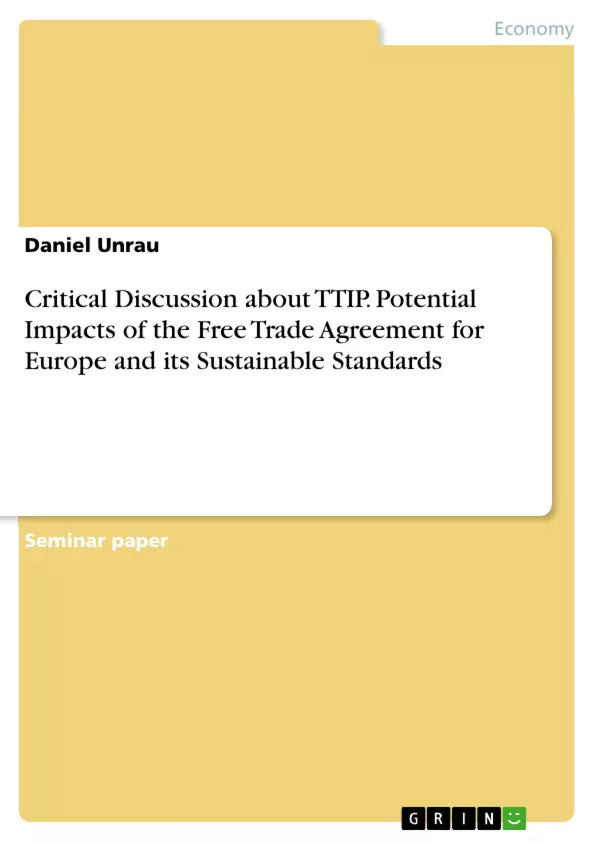TTIP is a trade and investment agreement being negotiated between the United States and the European Union, since the 17th of June 2013. On that day, US-president Obama and former EU commission president Barrosso announced the beginning of negotiations, which currently are in the 13th round of negotiations.
Objective is to increase access to markets on both sides of the atlantic, by dismantling customs and other trade barriers. Additionally, the agreement is supposed to minimize constraints for commercial services, improve investment safety and equality of competition, and facilitate the entry to public contracts on all governmental levels.
In the following, I will analyse and discuss the main arguments of TTIP opponents to discover what the impacts of the free trade and investment agreement would be for Europe.
According to the Bertelsmann-Stiftung “all states would benefit from an agreement, and increases in trade with the USA of 20-30 percent per state are expected”. Furthermore, TTIP shall increase the turnover of companies, because of an increasing trading volume, which should positively affect job safety and quality. Studies have also shown that e.g. the german economy will save expenses for customs handling which then could be invested in companies and their work places. Thus, real wage is expected to increase for all educational groups. But also SMEs (small-medium enterprises) should profit, which nowadays cannot affort certification in the US.
The federal ministry of economy and energy in Germany promises, there will not be any negative consequences for sustainable development, since it is a prior aim for both parties. The improvement in trade shall not be at costs of social or environment stand-ards, labour law or industrial safety.
Inhaltsverzeichnis (Table of Contents)
- Introduction
- General Information about TTIP
- Attitudes towards TTIP (Germany vs. United States)
- Status Quo - Boundaries in Transatlantic Trade TTIP tackles
- Market Access
- Regulatory Cooperation
- Rules
- Threats
- The Investment Court System and its consequences
- Rules for banking supervision
- Loss of working places
- Privatisation
- Antibiotics and hormones in groceries
- Import of gentically changed food and softer labeling obligations
- Consequences for small and local enterprises
- REACH - If TTIP includes the chemistry sector
- Why is the EU considering TTIP?
- Conclusion
- Impacts on European standards
- Author's Opinion
Zielsetzung und Themenschwerpunkte (Objectives and Key Themes)
The purpose of this paper is to critically discuss the Transatlantic Trade and Investment Partnership (TTIP) and its potential impacts on Europe and its sustainable standards. The paper explores the arguments for and against TTIP, focusing on the potential benefits and risks of the agreement.
- The potential benefits of TTIP for the European economy, including increased trade and investment.
- The potential threats posed by TTIP to European standards in areas such as food safety, environmental protection, and labor rights.
- The role of transparency and public participation in the TTIP negotiations.
- The impact of TTIP on the European Union's ability to maintain its own regulatory framework.
- The potential for TTIP to promote sustainable development.
Zusammenfassung der Kapitel (Chapter Summaries)
The introduction provides an overview of TTIP, outlining its objectives and the key players involved in the negotiations. It also discusses the potential benefits of the agreement for both the EU and the US.
The second chapter examines the existing boundaries in transatlantic trade that TTIP aims to address, focusing on market access, regulatory cooperation, and rules.
The third chapter outlines the potential threats posed by TTIP, exploring concerns about the impact of the agreement on areas such as the investment court system, banking supervision, employment, and environmental standards.
The fourth chapter explores the reasons behind the EU's interest in TTIP, examining the potential benefits and risks of the agreement from the EU's perspective.
Schlüsselwörter (Keywords)
The main keywords and focus topics of this paper include TTIP, Transatlantic Trade and Investment Partnership, free trade agreement, sustainable standards, European Union, United States, trade barriers, investment court system, regulatory cooperation, food safety, environmental protection, labor rights, transparency, and public participation.
- Quote paper
- Daniel Unrau (Author), 2016, Critical Discussion about TTIP. Potential Impacts of the Free Trade Agreement for Europe and its Sustainable Standards, Munich, GRIN Verlag, https://www.grin.com/document/338822



